Related Research Articles
Mitsukurinidae is a family of sharks with one living genus, Mitsukurina, and four fossil genera: Anomotodon, Protoscapanorhynchus, Scapanorhynchus, and Woellsteinia, though some taxonomists consider Scapanorhynchus to be a synonym of Mitsukurina. The only known living species is the goblin shark, Mitsukurina owstoni.

Gadus is a genus of demersal fish in the family Gadidae, commonly known as cod, although there are additional cod species in other genera. The best known member of the genus is the Atlantic cod.

Acropomatidae is a family of fish in the order Perciformes, commonly known as lanternbellies. Acropoma species are notable for having light-emitting organs along their undersides. They are found in all temperate and tropical oceans, usually at depths of several hundred meters. There are about 32 species in as many as 9 genera, although some authorities recognise fewer genera than Fishbase does.
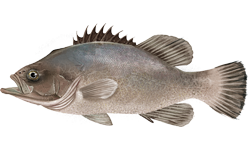
The wreckfish are a family, Polyprionidae in the suborder Percoidei of the order Perciformes.
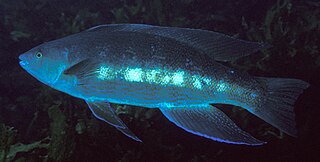
The Odacidae are a small family of ray-finned fishes commonly known as cales and weed whitings, formerly classified within the order Perciformes. They are related to the much larger families of the wrasses and parrotfish. More recent workers have classified this family within the order Labriformes, alongside the wrasses and parrotfishes, within the clade Percomorpha.

Stichaeidae, the pricklebacks or shannies, are a family of marine ray-finned fishes in the suborder Zoarcoidei of the order Scorpaeniformes. Most species are found in the North Pacific Ocean with a few in the North Atlantic Ocean.

The Platycephalidae are a family of marine fish, most commonly referred to as flatheads. They are relatives of the popular lionfish, belonging to the order Scorpaeniformes.

Plectropomus, commonly known as the coral groupers, is a genus of marine ray-finned fish, groupers from the subfamily Epinephelinae, part of the family Serranidae, which also includes the anthias and sea basses. They are found in the Indo-Pacific region.

Variola, the lyretails, is a genus of marine ray-finned fish, groupers from the subfamily Epinephelinae, part of the family Serranidae, which also includes the anthias and sea basses. They are found in the tropical Indo-Pacific and their distribution extends from the Red Sea to South Africa across the Indian Ocean and east to the islands of the central Pacific.
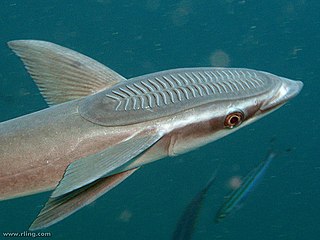
Echeneis is a genus of fish in the family Echeneidae, the remoras. The genus is distributed in the Atlantic, Pacific and Indian Oceans.
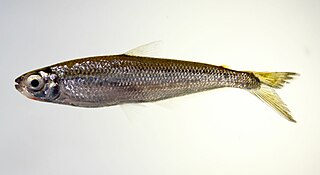
Iguanodectes is a genus of freshwater fish found in tropical South America, with eight currently described species. They are all small tetras, none longer than 5 inches, and often have attractive silvery or striped scales, which makes them a target for the ornamental fish industry. Alongside the genus Piabucus, it is in the subfamily Iguanodectinae, which in turn is in the family Iguanodectidae. The genus Bryconops, which is also in Iguanodectidae, makes up a sister clade to Iguanodectinae.

Clinocottus globiceps, the mosshead sculpin or globe-headed sculpin, is a species of marine ray-finned fish belonging to the family Cottidae, the typical sculpins. This sculpin is found in the northeastern Pacific.
Leptosynanceia is a monotypic genus of ray-finned fish belonging to the subfamily Synanceiinae, the stonefishes, which is classified within the family Scorpaenidae, the scorpionfishes and relatives, its only species is Leptosynanceia asteroblepa which is called the mangrove stonefish in Malaysia. This species native to the brackish and fresh waters of Southeast Asia. This species grows to a total length of 23 centimetres (9.1 in). This species is an extremely dangerous fish whose venom can cause a human to die within 1 to 2 hours after contact. The pain caused by the venom is described as "agonizing".
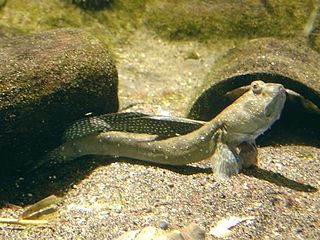
Boleophthalmus is a genus of mudskippers native to the Indian Ocean and the western Pacific Ocean.
Boleophthalmus dussumieri, Dussumier's mudskipper, is a species of mudskipper native to the Indian Ocean where it can be found on mudflats in fresh, brackish and marine waters of Iraq, Pakistan and India as well as probably in Bangladesh. This species can reach a length of 18.7 centimetres (7.4 in) TL.
Glyptothorax armeniacus, the Armenian mountain catfish, is a species of catfish that was first described by Berg, 1918. Glyptothorax armeniacus is a species in genus Glyptothorax, family Sisoridae and order Siluriformes. No subspecies are listed in Catalogue of Life. It is endemic to southern and eastern Turkey.

Rhabdosargus is a genus of ray-finned fish belonging to the family Sparidae, which includes the seabreams and porgies. These fishes are found in the southeastern Atlantic Ocean and throughout the Indo-West Pacific, although mainly in the western Indian Ocean.
The Cichlid Room Companion (CRC) is a membership-based webpage dedicated to the fishes of the Cichlid family (Cichlidae). The site was launched in May 1996 and offers arguably the most comprehensive authoritative catalogue of cichlids on the web, which is illustrated with more than 25,000 photographs of fishes and 2,000 of habitats, as well as over 300 videos of cichlids and their habitats. It also “offers access to ample information about 253 genera and 2371 species”, a discussion forum as well as many articles about taxonomy, natural history, fish-keeping, field accounts, conservation, and other cichlid related topics; mostly written by citizen scientists and people who specialize in cichlids. The species summaries provided in the form of profiles include taxonomic, distribution and habitat, distribution maps, conservation, natural history, captive maintenance, images, videos, collection records, and an extensive bibliography of the species included and have been prepared by world-class specialists. A document establishes the standards followed in the preparation and maintenance of the cichlid catalogue. The site is administered by its creator and editor, Juan Miguel Artigas-Azas, a naturalist, who is also an aquarist and a nature photographer. In 2008, the American Cichlid Association (ACA) awarded Artigas-Azas the Guy Jordan Retrospective Award, which is the maximum honor that association gives to people who have done extensive contribution to the international cichlid hobby.
William Neil Eschmeyer, also known as Bill Eschmeyer, is an American ichthyologist. He is the founder and developer of the database and reference work Catalog of Fishes, hosted by the California Academy of Sciences and available both on-line and in print.
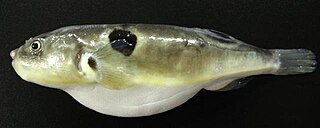
Takifugu obscurus or the obscure pufferfish is a species of euryhaline, anadromous pufferfish first described by T. Abe in 1949. It has been categorized by the IUCN as a least-concern species globally since 2014; in South Korea, it is however classified as an endangered species due to overfishing of its endemic populations. The Catalogue of Life lists no subspecies of Takifugu obscurus. The species prefers deeper, clearer areas of brackish and fresh water, and is found in estuaries, as well as rivers and tributaries thereof such as the South Korean rivers Geum, Han, and Imjin, or the Tamsui River. The species is endemic to North and South Korea, the Sea of Japan, and the East and South China Seas. Uses of Takifugu obscurus include human consumption, use in animal testing, and owning specimens as pets. As with most species of pufferfish, several organs of Takifugu obscurus contain tetrodotoxin, making it potentially poisonous if not prepared safely by trained persons.
References
- ↑ FishBase Catalogue of Life, ITIS: Integrated Taxonomic Information System (15 Feb 2015)
- ↑ Bailly, N. (2010) Why there may be discrepancies in the assessment of scientific names between the Catalog of Fishes and FishBase FishBase
- ↑ Eschmeyer WN, Fong JD (2015) Species by family/subfamily in the Catalog of Fishes California Academy of Sciences (15 Feb 2015)
- ↑ Biodiversity Information Projects of the World: Catalog of Fishes. Archived 2015-02-15 at the Wayback Machine . Biodiversity Information Standards (TDWG) project.
- ↑ Rainer Froese: Eschmeyer's Catalog of Fishes Archived 2022-01-07 at the Wayback Machine FishBase (15 Feb 2015)